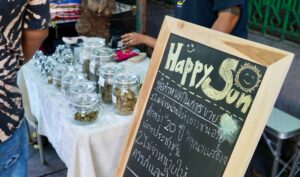
Asian countries are often considered to have stricter regulations on cannabis compared to the Americas and Europe. Cannabis, also known as marijuana, weed, or ganja, is prohibited in most Asian countries. Its use, cultivation, and trafficking are heavily penalized across many Asian nations, with punishments ranging from long prison sentences to rehabilitation facilities and even death penalties in some extreme cases.
However, Asia, particularly Southeast Asia, is also recognized as one of the world’s largest sources of cannabis. Given its status as a significant cannabis supplier, it’s likely that local residents have relatively easy access to cannabis, and many individuals in the region may even make a living from cannabis cultivation.
There are regions within Asia, like Thailand, where cannabis has been legalized, allowing households to cultivate it, and where perceptions of cannabis are gradually changing.
Historical background as a reason
The stringent restrictions on cannabis and narcotics in Asia are deeply influenced by historical factors. The origins of cannabis are said to trace back to China, where it was first cultivated in what is now the northwestern part of the country. Cannabis cultivation then spread and became commercialized across various countries.
In the 19th century, opium, a narcotic extracted from plants of the poppy family, gained popularity in China. This led to the Opium Wars and had significant consequences for the Asian region.
Southeast Asia is home to the “Golden Triangle,” a notorious area for narcotics production. The Golden Triangle, located in the mountainous region where Thailand, Myanmar, and Laos intersect along the Mekong River, is renowned as a major hub for narcotics trafficking. It’s particularly associated with the production and trade of opium, methamphetamines, and heroin.
Though opium cultivation was once prevalent in the region, efforts such as eradication campaigns have led to changes. Cannabis, however, is still grown in this area, and it might have become associated with the negative image tied to substances like opium and methamphetamines due to this historical context.
These historical factors have contributed to the perception of cannabis as being on par with narcotics.
Improvement of Cannabis Image
For a long time, Thailand had strict regulations on cannabis, but in 2018, medical cannabis was legalized, followed by full cannabis legalization, including cultivation for personal use. South Korea also legalized medical cannabis in 2018. While several other Asian countries still have restrictions on cannabis, there are reports of discussions towards legalizing medical cannabis in some of these nations.
Research on cannabis has advanced over the years, demonstrating the effectiveness of cannabis compounds for various medical conditions, stress relief, and pain management. Cannabis-derived treatments are actually being used in hospitals and clinics based on these research findings. These positive outcomes have contributed to improving the perception of cannabis.
Even in many Asian countries, CBD products that do not contain the psychoactive THC compound have been legalized. A variety of CBD products are available on the market, contributing to the growth of the CBD industry.
In Conclusion
We’ve discussed why cannabis is strictly regulated in Asia, based on historical backgrounds. In the past, narcotics and cannabis were often conflated, leading to negative perceptions. However, as research on cannabis has progressed, its image has been improving. Thailand has legalized cannabis, and South Korea has legalized medical cannabis. Other countries are also engaging in cannabis-related discussions, and it’s anticipated that more countries will move towards legalization in the coming years.

